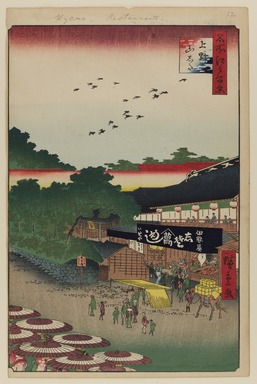
Artist:Utagawa Hiroshige
Medium: Woodblock print
Geograhical Locations:
Dates:10th month of 1858
Dimensions: Image: 13 3/16 x 8 3/4 in. (33.5 x 22.2 cm) Sheet: 14 3/16 x 9 1/4 in. (36 x 23.5 cm)
Collections:
Exhibitions:
Accession Number: 30.1478.12
Image: 30.1478.12_PS20.jpg,
Catalogue Description: This is the area down as Yamashita ("Below the Mountain"), the broad open space extending from the southern approach to Kan'eiji (the "mountain": see previous print) along around its eastern side. Here the stone-walled enclosure (the black wall at left center) leads into the temple compound. To the lower left is a procession of parasoled ladies, possibly a group of ladies-in-waiting from one of the daimyo mansions, on their way to Kan'eiji to pay their respects on the memorial day of the Tokugawa ancestor buried there and enjoying the cherry blossoms along the way. The small shrine hidden in the woods is Gojo Tenjin, and the adjacent restaurant, the Iseya, advertises a dish known as shisomeshi, rice blended with pickled shiso (a minty herb). Iseya later adopted the flying-goose motif from its ridge ornament as the basis of a new shop name, as well as a new dish: Gannabe ("goose-pot"), a kind of chicken stew. The interior here shows a fish shop below and the restaurant above; all depicted in bright detail. A flock of crows flies overhead. This is one of three prints in the "One Hundred Famous Views of Edo," together with pls. 41 and 114, that bear the censor's seals for the Tenth Month of 1858, the month following Hiroshige's death. The artist may have left completed designs at the time of his death which had not been formally approved. However, the theory has been advanced that these three prints were in fact the work of Hiroshige II. Reference is made to Uchida Minoru, "Hiroshige" (1930). It may be that Hiroshige himself executed preliminary sketches and that it was only the final version which was executed after his death. It is also possible, noting the close master-disciple relations, that a disciple other than Shigenobu, the future Hiroshige II, was involved.